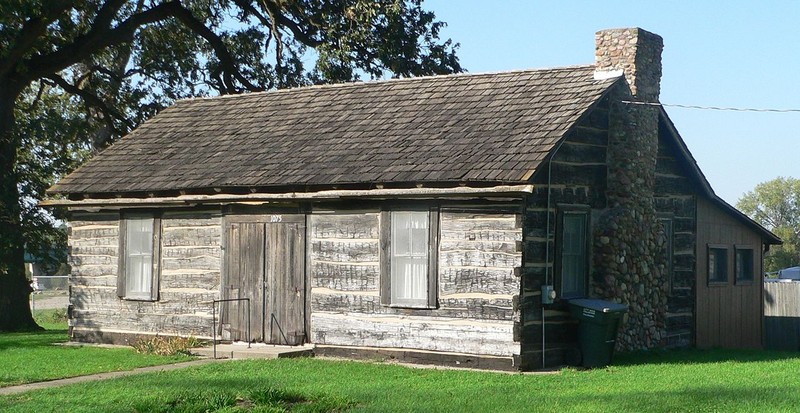Theophile Bruguier Cabin
Introduction
Text-to-speech Audio
Theophile Bruguier (1813-1895), Sioux City's first settler of European origin, built this cabin around 1860. Located in Riverside Park today, the cabin is believed to be the oldest building in the city. Bruguier, who worked as a trader for the American Fur Company, built the home using hand-hewn cottonwood timbers with dovetail joints. The cabin was one of around five buildings Bruguier built on the property and it was likely used as a kitchen. A local organization called the Girls of 68' manages the cabin and opens it to the public on occasion during the summer. The log cabin was added to the National Register of Historic Places in 2000.
Images
Built around 1860, the Theophile Bruguier Cabin is the oldest structure in Sioux City.

Backstory and Context
Text-to-speech Audio
Theophile Bruguier was born on August 31, 1813 in Quebec, Canada. He studied law with the intent of becoming an attorney but to the chagrin of his parents, he sought adventure instead. He immigrated to the U.S. in 1835, moving to St. Louis, Missouri by way of Green Bay, Wisconsin and down the Mississippi River. He arrived on November 1 and was hired by the American Fur Company. He was assigned to Fort Pierre, which was located on the Missouri River, to trade with Indians. There, he met and became friends with Chief War Eagle, who led the Yankton band of the Dakota Sioux. Bruguier married two of War Eagle's daughters, Dawn and Blazing Cloud. It appears they had a number of children.
Bruguier worked for the company until 1849 when he established his own fur trading business. He, his wives and Chief War Eagle moved to present-day Sioux City. Bruguier bought 560 acres of farm land along the Big Sioux River and built several log structures, including the cabin. The settlement became a stopping place for Indians, people traveling on the river, and the first settlers to the area. Bruguier grew corn, potatoes and other vegetables, and raised cattle as well. His farm was one of the largest in the region.
He also played a large role in the establishment of Sioux City. In the early 1850s on a trading trip downriver, Bruguier met Council Bluffs resident James A. Jackson and his step-father-in law, John Cook, who was a government surveyor, and told them about the potential for a town site where Sioux City is now. He persuaded both men who established the Sioux City Town-Site Company in 1854. Cook finished surveying and platting the town in the Spring of 1855. Beginning with two log cabins, the town grew to about 90 buildings and 400 residents the next year. Bruguier lived on the farm until 1869. By then Chief War Eagle and Dawn and Blazing had died and Bruguier married his second wife in 1862. They moved to a farm near Salix, Iowa where Bruguier died on February 13, 1895.
Over time, many of the original buildings in Sioux City were torn down to make room for new ones. Despite the interest of some residents in the early 1900s in documenting old buildings, the city showed little concern about preserving them. However, this sentiment changed in 1933 when a house was set to be demolished. When workers removed the siding they revealed an old log cabin underneath. The person who was in charge of demolishing the house, Rev. John Hantla, determined that the cabin was in fact Bruguier's. The city dismantled it in 1934 and reconstructed it in Riverside Park in 1936.
Sources
"Bruguier's Cabin." Sioux City History. Accessed April 1, 2022. http://www.siouxcityhistory.org/historic-sites/84-bruguiers-cabin.
"Girls of '68 to host open house at Bruguier Cabin on Sunday." June 12, 2021. https://siouxcityjournal.com/news/local/briefs/girls-of-68-to-host-open-house-at-bruguier-cabin-on-sunday/article_ab2c333d-3cf7-5d8e-befe-210502b43746.html.
Schalge, Gretchen E. "Bruguier, Theophile Cabin." National Park Service - National Register of Historic Places Nomination Form. August 14, 2000. https://npgallery.nps.gov/NRHP/GetAsset/NRHP/00000918_text.
Wikimedia Commons: https://commons.wikimedia.org/wiki/File:Theophile_Bruguier_cabin_from_NE_1.JPG
